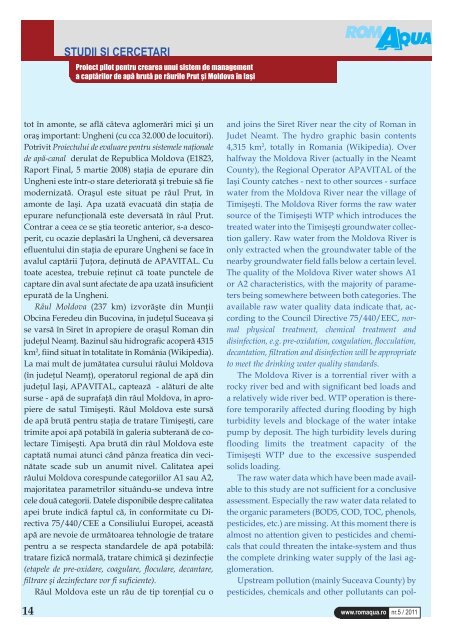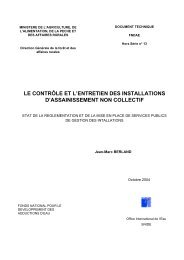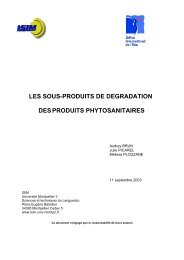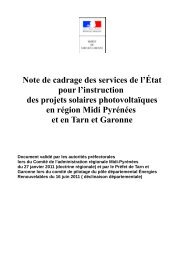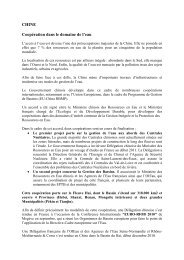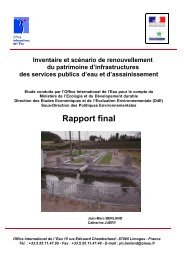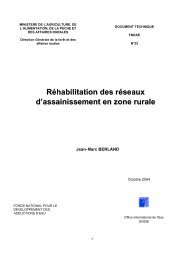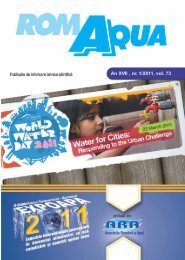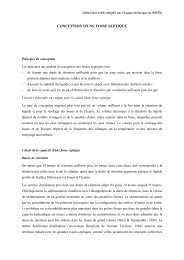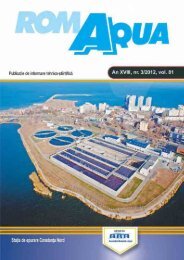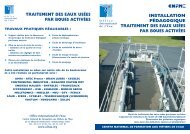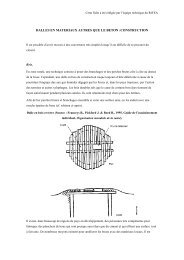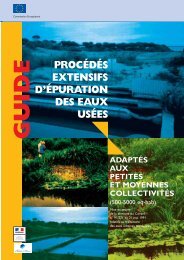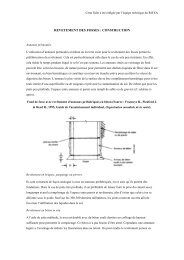vol 77 n° 5 2011 - Office International de l'Eau
vol 77 n° 5 2011 - Office International de l'Eau
vol 77 n° 5 2011 - Office International de l'Eau
You also want an ePaper? Increase the reach of your titles
YUMPU automatically turns print PDFs into web optimized ePapers that Google loves.
STUDII SI CERCETARI<br />
Proiect pilot pentru crearea unui sistem <strong>de</strong> management<br />
a captărilor <strong>de</strong> apă brută pe râurile Prut şi moldova în iaşi<br />
tot în amonte, se află câteva aglomerări mici şi un<br />
oraş important: Ungheni (cu cca 32.000 <strong>de</strong> locuitori).<br />
Potrivit Proiectului <strong>de</strong> evaluare pentru sistemele naţionale<br />
<strong>de</strong> apă-canal <strong>de</strong>rulat <strong>de</strong> Republica Moldova (E1823,<br />
Raport Final, 5 martie 2008) staţia <strong>de</strong> epurare din<br />
Ungheni este într-o stare <strong>de</strong>teriorată şi trebuie să fie<br />
mo<strong>de</strong>rnizată. Oraşul este situat pe râul Prut, în<br />
amonte <strong>de</strong> Iaşi. Apa uzată evacuată din staţia <strong>de</strong><br />
epurare nefuncţională este <strong>de</strong>versată în râul Prut.<br />
Contrar a ceea ce se ştia teoretic anterior, s-a <strong>de</strong>scoperit,<br />
cu ocazie <strong>de</strong>plasări la Ungheni, că <strong>de</strong>versarea<br />
efluentului din staţia <strong>de</strong> epurare Ungheni se face în<br />
avalul captării Ţuţora, <strong>de</strong>ţinută <strong>de</strong> APAVITAL. Cu<br />
toate acestea, trebuie reţinut că toate punctele <strong>de</strong><br />
captare din aval sunt afectate <strong>de</strong> apa uzată insuficient<br />
epurată <strong>de</strong> la Ungheni.<br />
Râul Moldova (237 km) izvorăşte din Munţii<br />
Obcina Fere<strong>de</strong>u din Bucovina, în ju<strong>de</strong>ţul Suceava şi<br />
se varsă în Siret în apropiere <strong>de</strong> oraşul Roman din<br />
ju<strong>de</strong>ţul Neamţ. Bazinul său hidrografic acoperă 4315<br />
km 2 , fiind situat în totalitate în România (Wikipedia).<br />
La mai mult <strong>de</strong> jumătatea cursului râului Moldova<br />
(în ju<strong>de</strong>ţul Neamţ), operatorul regional <strong>de</strong> apă din<br />
ju<strong>de</strong>ţul Iaşi, APAVITAL, captează - alături <strong>de</strong> alte<br />
surse - apă <strong>de</strong> suprafaţă din râul Moldova, în apropiere<br />
<strong>de</strong> satul Timişeşti. Râul Moldova este sursă<br />
<strong>de</strong> apă brută pentru staţia <strong>de</strong> tratare Timişeşti, care<br />
trimite apoi apă potabilă în galeria subterană <strong>de</strong> colectare<br />
Timişeşti. Apa brută din râul Moldova este<br />
captată numai atunci când pânza freatica din vecinătate<br />
sca<strong>de</strong> sub un anumit nivel. Calitatea apei<br />
râului Moldova corespun<strong>de</strong> categoriilor A1 sau A2,<br />
majoritatea parametrilor situându-se un<strong>de</strong>va între<br />
cele două categorii. Datele disponibile <strong>de</strong>spre calitatea<br />
apei brute indică faptul că, în conformitate cu Directiva<br />
75/440/CEE a Consiliului Europei, această<br />
apă are nevoie <strong>de</strong> următoarea tehnologie <strong>de</strong> tratare<br />
pentru a se respecta standar<strong>de</strong>le <strong>de</strong> apă potabilă:<br />
tratare fizică normală, tratare chimică şi <strong>de</strong>zinfecţie<br />
(etapele <strong>de</strong> pre-oxidare, coagulare, floculare, <strong>de</strong>cantare,<br />
filtrare şi <strong>de</strong>zinfectare vor fi suficiente).<br />
Râul Moldova este un râu <strong>de</strong> tip torenţial cu o<br />
and joins the Siret River near the city of Roman in<br />
Ju<strong>de</strong>t Neamt. The hydro graphic basin contents<br />
4,315 km 2 , totally in Romania (Wikipedia). Over<br />
halfway the Moldova River (actually in the Neamt<br />
County), the Regional Operator APAVITAL of the<br />
Iaşi County catches - next to other sources - surface<br />
water from the Moldova River near the village of<br />
Timişeşti. The Moldova River forms the raw water<br />
source of the Timişeşti WTP which introduces the<br />
treated water into the Timişeşti groundwater collection<br />
gallery. Raw water from the Moldova River is<br />
only extracted when the groundwater table of the<br />
nearby groundwater field falls below a certain level.<br />
The quality of the Moldova River water shows A1<br />
or A2 characteristics, with the majority of parameters<br />
being somewhere between both categories. The<br />
available raw water quality data indicate that, according<br />
to the Council Directive 75/440/EEC, normal<br />
physical treatment, chemical treatment and<br />
disinfection, e.g. pre-oxidation, coagulation, flocculation,<br />
<strong>de</strong>cantation, filtration and disinfection will be appropriate<br />
to meet the drinking water quality standards.<br />
The Moldova River is a torrential river with a<br />
rocky river bed and with significant bed loads and<br />
a relatively wi<strong>de</strong> river bed. WTP operation is therefore<br />
temporarily affected during flooding by high<br />
turbidity levels and blockage of the water intake<br />
pump by <strong>de</strong>posit. The high turbidity levels during<br />
flooding limits the treatment capacity of the<br />
Timişeşti WTP due to the excessive suspen<strong>de</strong>d<br />
solids loading.<br />
The raw water data which have been ma<strong>de</strong> available<br />
to this study are not sufficient for a conclusive<br />
assessment. Especially the raw water data related to<br />
the organic parameters (BOD5, COD, TOC, phenols,<br />
pestici<strong>de</strong>s, etc.) are missing. At this moment there is<br />
almost no attention given to pestici<strong>de</strong>s and chemicals<br />
that could threaten the intake-system and thus<br />
the complete drinking water supply of the Iasi agglomeration.<br />
Upstream pollution (mainly Suceava County) by<br />
pestici<strong>de</strong>s, chemicals and other pollutants can pol-<br />
14 www.romaqua.ro nr.5 / <strong>2011</strong>


